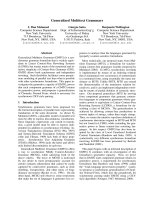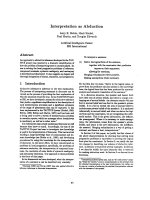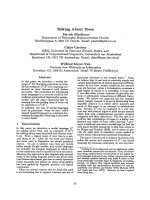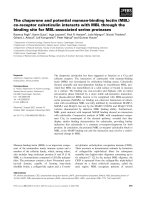Báo cáo khoa học: "COORDINATION INUNIFICATION-BASED GRAMMARS" pot
Bạn đang xem bản rút gọn của tài liệu. Xem và tải ngay bản đầy đủ của tài liệu tại đây (507.52 KB, 6 trang )
COORDINATION IN UNIFICATION-BASED GRAMMARS
Richard P. Cooper
Department of Psychology
University College London
London WC1E 6BT, U.K.
JANET:
ABSTRACT
Within unification-based grammar formalisms,
providing a treatment of cross-categorial coor-
dination is problematic, and most current solu-
tions either over-generate or under-generate. In
this paper we consider an approach to coordi-
nation involving "composite" feature structures,
which describe coordinate phrases, and present
the augmentation to the logic of feature struc-
tures required to admit such feature structures.
This augmentation involves the addition of two
connectives, composite conjunction and compos-
ite disjunction, which interact to allow cross-
categorial coordination data to be captured ex-
actly. The connectives are initially considered to
function only in the domain of atomic values, be-
fore their domain of application is extended to
cover complex feature structures. Satisfiability
conditions for the connectives in terms of deter-
ministic finite state automata are given, both for
the atomic case and for the more complex case.
Finally, the Prolog implementation of the connec-
tives is discussed, and it is illustrated how, in the
atomic case, and with the use of the freeze/2
predicate of second generation Prologs, the con-
nectives may be implemented.
The Problem
Given a modern unification-based grammar,
such
as HPSG,
or PATR/FUG-styIe grammars,
where feature structure descriptions are associ-
ated with the constituents of the grammar, and
unification is used to build the descriptions of
constituents from those of their subconstituents,
providing a treatment of coordination, especially
cross-categorial coordination, is problematic. It
is well known that coordination is not restricted
to like categories (see (1)), so it is too restric-
tive to require that the syntactic category of a
coordinate phrase be just the unification of the
syntactic categories of the conjuncts. Indeed, the
data suggest that the syntactic categories of the
conjuncts need not unify.
(1) a. Tigger became famous and a com-
plete snob.
b. Tigger is a large bouncy kitten and
proud of it.
Furthermore, it is only possible to coordinate
certain phrases within certain syntactic contexts.
Whilst the examples in (1) are grammatical, those
in (2) are not, although the same constituents are
coordinated in each case.
(2) a. *Famous and a complete snob chased
Fido.
b. *A large bouncy kitten and proud of
it likes Tom.
The difference between the examples in (1) and
(2) is the syntactic context in which the coordi-
nated phrase appears. The relevant generalisa-
tion, made by Sag et al. (1985) with respect to
GPSG, is that constituents may coordinate if and
only if the description of each constituent unifies
with the relevant description in the grammar rule
which licenses the phrase containing the coordi-
nate structure. Example (la) is grammatical be-
cause the phrase structure rule which licenses the
constituent became famous and a complete snob
requires that famous and a complete snob unify
with the partial description of the object sub-
categorised for by became, and the descriptions
of each of the conjuncts, famous and a complete
snob, actually do unify with that partial descrip-
tion: became requires that its object be "either an
NP or an AP", and each of famous and a com-
plete snob is "either an NP or an AP". (lb) is
grammatical for analogous reasons, though is is
less fussy about its object, also allowing PPs and
predicative VPs to fill the position. (2a) is un-
grammatical as chased requires that its subject
be a noun phrase. Whilst this is true of a com.
167 -
plete snob, it is not true of famous, so the descrip-
tion of famous does not unify with the descrip-
tion which chase requires of its subject. (2b) is
ungrammatical for similar reasons.
Two Approaches to a Solution
Two approaches to this problem are immediate.
Firstly, we may try to capture the intuition that
each conjunct must unify with the requirements
of the appropriate grammar rule by generalising
all grammar rules to allow for coordinated phrases
in all positions. This general approach follows
that of Shieber (1989), and involves the use of
semi-unification. Note that this does not involve
a grammar rule licensing coordinate constituents
such as a and fl: following this approach c~ and
/~ can never be a constituent in its own right.
An alternate approach is to preserve the orig-
inal grammar rules, but generalise the notion of
syntactic category to license composite categories
categories built from other categories and
introduce a rule licensing coordinate structures
which have such composite syntactic categories.
That is, we introduce a grammar rule such that
if a and ~ are constituents, then a and ~ is also
a constituent, and the syntactic category of this
constituent is a composite of the syntactic cate-
gories of a and ft.
Within a unification-based approach, this gen-
eralisation of syntactic category requires a gener-
alisation of the logic of feature structures, with
an associated generalisation of unification. This
is the approach which we adopt in this paper.
One of the consequences of this approadl is that
for (almost) any constituents a and fl, the gram-
mar should also license the string a and fl as
a constituent, irrespective of whether there axe
any contexts in which this constituent may occur.
Thus our grammar might admit in the garden and
chases Fido as a constituent, though there may
be no contexts which license such a constituent.
Our approach differs from other approaches
to cross-categorial coordination (such as those
employing generalisation, or that of Proudiau
& Goddeau (1987)) which have been suggested
in the unification grammar literature in that
it involves a real augmentation of the logic of
feature structures. Other approaches which do
not involve this augmentation tend to ovel-
generate (the approaches employing general.
isation) or under-generate (the approach of
Proudian & Goddeau).
Generalisation over-generates because in gen-
eralisation conflicting values are ignored. In the
ease of became, assuming that we analyse became
as requiring an object whose description unifies
with
[CATEGORy
NP V AP], generaiisation would
license (la), as well as both of the examples in (3).
(3) a. *Tigger became famous and in the
garden.
b. *Tigger became a complete snob and
in the garden.
This is because the generalisation of the de-
scriptions of the two conjuncts ([CATEGORY AP]
and [CATEGORY PP] in the case of (3a) and [CAT-
gooltv NP] and [CATEGORY PP] in the case of
(3b)) is in each case [CATEGORY _l_], which uni-
fies with the [CATEGORY NP V AP] requirement
of became.
It is not clear how the approach of Proudian &
Goddeau could be applied to the became example:
the disjunctive :subcategorisation requirements of
became cannotbe treated within their approach.
For further details see Cooper (1990).
Composite Atomic Values
Following Kasper & Rounds (1990), and ear-
lier work by the same authors (Rounds & Kasper
(1986) and Kasper & Rounds (1986)), we adopt
a logical approach to feature structures via an
equational logic. The domain of well-formed for-
mulae is defined inductively in terms of a set A of
atomic values and a set L of labels or attributes.
These formulae are interpreted as descriptions of
deterministic finite state automata.
In the formulation of Kasper & Rounds, these
automata have atomic values assigned to (some
of) their terminal states. A simplifed reading of
the coordination data suggests that these values
need not be atomic, and that there is structure
on this domain of "atomic" values. To model this
structure we introduce an operator "~", which
we term composite conjunction, such that if a and
]~ are atomic values, then a ,~/~ is also an atomic
Value. Informally, if a large bouncy kitten is de-
scribed by the pair [CATEGORY NP] and proud of
it is described by the pair [CATEGORY AP], then
any coordination of those constituents, such as
neither a large bouncy kitten nor proud of it will
be described by the pair [CATEGORY NP ~ AP].
Before discussing satisfiability, we consider
some of the properties of ~ :
- 168 -
• ^ is symmetric: a noun phrase coordinated
with an adjectival phrase is of the same cate-
gory as an adjectival phrase coordinated with
a noun phrase. Thus for all atomic values a
and/~, we require
• ^ is associative: in constructions involv-
ing more than two conjuncts the category of
the coordinate phrase is independent of the
bracketing. Hence for all atomic values a,/~
and % we require
^t =
• ^ is idempotent: the conjunction of two (or
more) constituents of category x is still of
category x: Hence for all atomic values a,
we require
These properties exactly correspond to the prop-
erties required of an operator on finite sets. For
full generality we thus take ^ to be an operator
on finite subsets of atomic values rather than a
binary operator satisfying the above conditions,
but for simplicity use the usual infix notation for
the binary case.
Given one further requirement, that for any a
(and hence that a^a = ^ {a}) the use of an op-
erator on sets directly reflects all of the above
properties:
= =
-^-= ^{.}
Given this structure on the domain of atomic
values, we restate the satisfiability require-
ments. We deal in terms of deterministic finite
state automata (DFSAS) specified as six-tuples,
(Q, q0, L, 5, A, lr), where
• Q is a set of atoms known as states,:
• q0 is a particular element of Q known as the
start state,
• L is a set of atoms known as labels,
• 6 is a partial function from [Q x L] to Q
known as the transition function,
• A is a set of atoms, and
• ~r is a function from final states (those states
from which according to/f there are no tran-
sitions) to
A.
To incorporate conjunctive composite values
we introduce structure on A, requiring that for
all finite subsets X of A, ^ X is in A. Satisfiabil-
ity of formulae involving composite conjunction
is defined as follows:
• -4~ ~{ax, a,~}iff.4=(Q,qo, L,6,A, tr)
~ where 6(q0,/) is undefined for each I in L and
a'(qo) -" ^ {al, , a,~}. 1
This is really just the same clause as for all atomic
values:
• .4 ~ aiff.A
= (Q, qo,L,6,A,~r)
where ~(q0,1)
is undefined for each 1 in L and ~r(q0) - a.
As such nothing has really changed yet, though
note that by an "atomic value" now we mean an
element of the domain A. The structure which
we have introduced on A means that strictly
speaking these values are not atomic. They are,
however, "atomic" in the feature structure sense:
they have no attributes.
The real trick in handling composite conjunc-
tive formulae correctly, however, comes in the
treatment of disjunction. We introduce to the
syntax a further connective ~, composite dis-
junction. As the name suggests, this is the ana.
logue of disjunction in the domain of composite
values. Like standard disjunction v exists only
in the syntax, and not in the semantics. For sat-
isfiability we have:
• .4 ~ (aV3) where a,/~EA iffA~a or
:
More generally:
• .4 ~ ~& where ~CA and 4~ is finite iff
.4 ~ ~ ~' for some subset (I)' of 4).
With this connective, disjunctive subcategori-
sation requirements may be replaced with com-
posite disjunctive requirements. The intuition be-
hind this modifcation stems from the fact that
if a constituent has a disjunctive subcategorisa-
ti0n requirement, then that requirement can be
met by any of the disjuncts, or the composite
of those disjuncts. To illustrate this reconsider
1For aimplidty we ignore connectivity of D~Xs. If con-
nectivity is
to be
included in the definitions, then in this
case Q must he the singleton
{qo}.
- 169 -
the example in (la). Originally the subcategori-
sation requirements of
became
might have been
stated with the disjunctive specification [CAT~
GORY NP V AP]. This could be satisfied by either
an NP or an AP, but not by a conjunctive com-
posite composed of an NP and an AP, i.e., not by
the result of conjoining an NP and an AP. To al-
low this we respecify the requirements on the sub-
categorised for object as [CATEGORY NP~tAP].
This requirement may be legitimately met by ei-
ther an NP or an AP
or
a conjunctive composite
NP~AP.
Composite Feature
Structures
This use of an algebra of atomic values allows
composites only to be formed at the atomic level.
That is, whilst we may form a ,'~/3 for a, f~ atomic,
we may not form a ~/3 where a,/3 are non-atomic
feature structures. However, such composites do
appear to be useful, if not necessary. In par-
ticular, in an HesG-like theory, the appropriate
thing to do in the case of coordinate structures
seems to be to form the composite of the HEAD
features of all conjuncts. The above approach
to composite atoms does not immediately gen-
eralise to allow composite feature structures. In
particular, whilst the intuitive behaviour of the
connectives should remain as above, the seman-
tic domain must be revised to allow a satisfactory
rendering of satisfiability.
With regard to syntax we revert back to an
unstructured domain A of atoms but augment
the system of Kasper & Rounds (1990) with two
clauses licensing composite formulae:
• A & is a valid formula if q) is a finite set, each
element of which is a valid formula;
e ~ (I) is a valid formula if (I) is a finite set, each
element of which is a valid formula.
The generalisation of satisfiability holds for
composite disjunction:
• .A ~ ~4 & iff .A ~ ,'~ 4' for some subset (I)' of
(I'.
We must alter the semantic domain, the domain
of deterministic finite state automata, however,
to allow a sensible rendering of satisfaction of
composite conjunctive formulae we need some-
thing like composite states to replace the compos-
ite atomic values of the preceding section.
In giving a semantics for ~ we take advantage
of the equivalence of ,'~ {a} and a. We begin by
generalising the notion of a deterministic finite
state automaton such that the transition function
maps states to sets of states:
A generalised deterministic finite state automa-
ton
(GDFSA) is a tuple (Q, qo, L, 6,A, 7r), where
• Q is a set of atoms known as states,
• qoEPow(Q)
is a distinguished set of states
known as the start state set,
• L is a set of atoms known as labels,
• 6 is a partial function from [Q x L] to
Pow(Q),
• A is a set of atoms, and
• ~ is a partial assignment of atoms to final
states.
Any DFSA ,A
"
(Q, qo,L,~f,A,~)
has a corre-
sponding ¢DFSA .A' given by
(Q,
{q0},
L, 6', A, It)
where 6'(q, I) {6(q, l)}.
Given a
GDFSA
.4 we define satisfiability of
conjunctive, disjunctive and atomic formulae as
usual. There is a slight differences in satisfiabil-
ity of path equations:
• .A ~ l : ~b: iff
.Aft
is defined and
.A/! ~ ~,
where if ~4: = (Q, {q}, L, 6, A, ~), then
.Aft =
(Q, 6(q, 0, L, 6, A,
This clause has been altered to enforce the re-
quirement that q0 be a singleton, and that 6 maps
this single element to a set. 2
The extensions for V and ~ are:
• .A ~ V • iff .A ~ ,~ (I) I for some subset (I)~ of
4~ (as above).
• .A ~ ~ iff for each ~b E 4~, there exists a
q' E q0 such that
(Q,{q'},L,6,A,7 0 ~ ~.
Note that in the case of • a singleton, this last
clause reduces to .A ~ ,'~ {~} iff ¢4 ~ d.
The reason why the satisfiability clauses for
these connectives are so simple resides principally
in the equivalence of ,~ {a} and a. We cannot fol-
low this approach in giving a semantics for stan-
dard set valued attributes because in the case of
sets we want {~} and ~ to be distinct.
2Again we are ignoring connectivity.
- ]70 -
Properties of Composites
The properties of composite feature structures
and the interaction of ~ and ~ may be briefly
summarised as follows:
• Disjunctive composite feature structures are
a syntactic construction. Like disjunctive
feature structures they exist in the language
but have no direct correlation with objects
in the world being modelled.
* Conjunctive composite feature structures de-
scribe composite objects which do exist in
the world being modelled.
* A disjunctive composite feature structure de-
scribes an object just in ease one of the dis-
juncts describes the object, or it describes a
composite object.
• A disjunctive composite feature structure de-
scribes a composite object just in case each
object in the composite is described by one
of the disjuncts.
• A conjunctive composite feature structure
describes an object just in case that object
is a composite object consisting of objects
which are described by each of the descrip-
tions making up the conjunctive composite
feature structure.
The crucial point here is that conjunctive
composite objects exist in the described world
whereas disjunctive composite objects do not.
An Example
To illustrate in detail the operation of composites
we return to the example of (la). In an nPSG-like
formalism (see Pollard & Sag (1987)) employing
composites, the object subcategorised for by
be-
came
would be required to satisfy:
I
SYNILO C I HEAD
L
SUBCAT
According to our satisfiability clauses above,
this may be satisfied by:
• an AP such as
famous,
having description
PHON
SYN[LOC
HEADIMAJ
SUBCAT
• an NP such
as a complete snob,
having de-
scription
PHOt~
a complete snob ]
s cA,
<)jj
• or ~a AP ~ NP such as
famous and a com-
plete snob,
having description s
sPHON
famous and a complete
snob "
The subcategorlsation requirements may not,
however, by satisfied by, for example, a PP, or any
conjunctive composite containing a PP. Hence the
examples in (3) are not Mmitted.
Implementation Issues
The problems of implementing a system involv-
ing composites really stem fromtheir requirement
for a proper implementation of disjunction. Im-
plementation may be approached by adopting a
strict division between the objects of the language
and the objects of the described world. Accord-
ing to this approach, and in Prolog, Prolog terms
~re taken to correspond to the objects in the se-
mantic domain, with Prolog clauses being inter-
preted much as in the syntax of an equational
logic, as constraints on those terms. Conjunctive
constraints correspond to unification. The for-
mation of conjunctive composites is also no prob-
lem: such objects exist in the semantic domain, so
structured terms may be constructed whose sub-
terms are the elements of the composite. Thus
if we implement the composite connectives as bi-
nary operators, * for ~ and + for ~, we may
form Prolog terms (A * B) corresponding to con-
junctive composites. Disjunction, and the use of
disjunctive composites, cannot, however, be im-
plemented in the same way. The problem with
disjunction is that we cannot normally be sure
which disjunct is appropriate, and a term of the
form (A + B) will not unify with the term A, as
is required by either form of disjunction. The
freeze/2 predicate of many second generation
Prologs provides some help here. For standard
aWe assume that the rule licensing coordinate struc-
tures unifies all corresponding values (such as the vahies
for each SUBCAT
attribute) except for the
values of
the
HEAD attributes. The value of the HEAD attribute of
the
coordinate structure is
the composite
of the values of the
HEAD attribute of each conjunct.
171
-
disjunction, we might augment feature structure
unification clauses (using <=> to represent the
unification operator and \/to represent standard
disjunction) with special clauses such as:
A <=>
CA1
\1 A2)
:-
freeze(A,
((A
<=> hl);.
(A <=> A2)))
Similarly for composite disjunction, we might
augment the unification clauses with:
A
<=>
(AI + A2)
:-
freeze(A, ((A
< >
A1);
(A <=> A2);
CA <=)
(A1
* A2))))
The idea is that the
~reeze/2
predicate de-
lays the evaluation of disjunctive constraints un-
til the relevant structure is sufficiently instanti-
ated. Unfortunately, "sufficiently instantiated"
here means that it is nonvar. Only in the case
of atoms is this normally sufficient. Thus the
above approach is suitable for the implementa-
tion of composites at the level of atoms, but not
suitable in the wider domain of composite feature
structures.
Concluding Remarks
In giving a treatment of coordination, and in
particular cross-categorial coordination, within a
unification-based grammar formalism we have in-
troduced composite feature structures which de-
scribe composite objects. A sharp distinction is
drawn between syntax and semantics: in the se-
mantic domain there is only one variety of com-
posite object, but in the syntactic domain there
are two forms of composite description, a con-
junctive composite description and a disjunctive
composite description. Satisfiability conditions
are given for the connectives in terms of a gener-
alised notion of deterministic finite state automa-
ton. Some issues which arise in the Prolog imple-
mentation of the connectives are also discussed.
REFERENCES
Cooper, Richard. Classification-Based Phrase
Structure Grammar: an Extended Revised
Version of :HPSG. Ph.D. Thesis, University
of Edinburgh. 1990.
Kasper, Robert & William Rounds. A Logical
Semantics for Feature Structures. In Pro-
ceedings of the ~4 th ACL, 1986, 257-265.
Kasper, Robert & William Rounds. The Logic
of Unification in Grammar. Linguistics and
Philosophy, 13, 1990, 35-58.
Pollard, Carl & Ivan Sag. Information-Based
Syntax and Semantics, Volume 1: Funda-
mentals. 1987, CSLI, Stanford.
Proudian, Derek & David Goddeau. Constitu-
ent Coordination in HPSG. CSLI Report
#CSLI-87-97, 1987.
Rounds, William & Robert Kasper. A Complete
Logical Calculus for Record Structures Rep-
resenting Linguistic Information. In Proceed-
ings of the 1 °t IEEE Symposium on Logic in
Computer Science, 1986, 38-43.
Sag, Ivan, Gerald Gazdar, Thomas Wasow and
Steven Weisler. Coordination and How to
Distinguish Categories. Natural Language
and Linguistic Theory, 3, 1985, 117-171.
Shieber, Stuart. Parsing and Type Inference for
Natural and Computer Languages. Ph.D.
Thesis, Stanford University, 1989.
ACKNOWLEDGEMENTS
This research was carried out at the Cen-
tre for Cognitive Science, Edinburgh, under
Commonwealth Scholarship and Fellowship Plan
AU0027. I am grateful to Robin Cooper, William
Rounds and Jerry Seligman for discussions con-
cerning this work, as well as to two :anonymous
referees for their comments on an earlier version
of this paper. All errors remain, of course, my
own.
- 172 -









